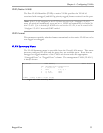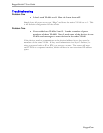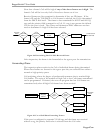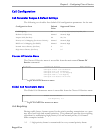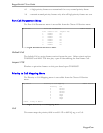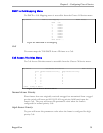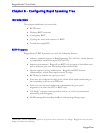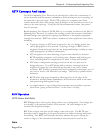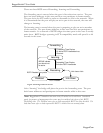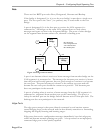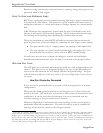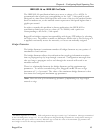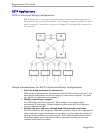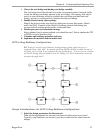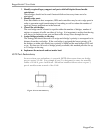
Chapter 6 – Configuring Rapid Spanning Tree
RSTP Concepts And Issues
The 802.1d Spanning Tree Protocol was developed to allow the construction of
robust networks that incorporate redundancy while pruning the active topology of
the network to prevent loops. While STP is effective, it requires that frame
transfer must halt after a link outage until all bridges in the network are sure to be
aware of the new topology. Using the 802.1d recommended values, this period
lasts 30 seconds.
Rapid Spanning Tree Protocol (IEEE 802.1w) is a further evolution of the 802.1d
Spanning Tree Protocol. It replaces the settling period with an active handshake
between bridges that guarantees topology information to be rapidly propagated
through the network. RSTP also offers a number of other significant innovations,
including:
• Topology changes in STP must be passed to the root bridge before they
can be propagated to the network. Topology changes in RSTP can be
originated from and acted upon by any designated bridges, leading to more
rapid propagation of address information.
• STP recognizes one state, blocking, for ports that should not forward.
RSTP explicitly recognizes two blocking roles, alternate and backup port
roles, including them in computations of when to learn and forward.
• STP relays configuration messages received on the root port out its
designated ports. If an STP bridge fails to receive a message from its
neighbor it cannot be sure where along the path to the root a failure
occurred. RSTP bridges generate their own configuration messages, even if
they fail to receive one from the root bridge. This leads to quicker failure
detection.
• RSTP offers edge port recognition, allowing ports at the edge of the
network to forward frames immediately after activation while at the same
time protecting them against loops.
• An improvement to age configuration messages more quickly to prevent
them from “going around in circles” in the event of a loop.
RSTP Operation
RSTP States And Roles
RSTP Bridges have roles to play, being either root or designated. One bridge, the
root bridge, is the practical center of the network. All other bridges in the
network are designated bridges.
RSTP also assigns each port of the bridge a state and a role. The RSTP state
describes what is happening at the port in relation to address learning and frame
forwarding. The RSTP role basically describes whether the port is facing the
center or edges of the network and whether it can currently be used or not.
State
RuggedCom
41



